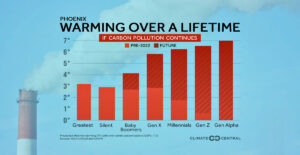Dear Friends,
We’re deep into summer in North America and the news is the heat. Not usual summer heat, but the kind that stops your breath and saps your will, and makes staying in your air-conditioned bubble a non-negotiable necessity. Records across the U.S. and the world are being shattered – the Iranian airport in the Persian Gulf hit a heartstopping 152°F – and it is not even August yet. And soberingly, most people in the world, about 80%, don’t have that air-conditioned bubble to retreat to.
This summer, as heat and rain extremes are hitting us harder and faster than experts predicted, it’s becoming clear that no home, neighborhood, city, or country is safe from the effects of climate change. And experts warn that we are not yet at a “new” normal, and that we are hurtling toward a future with even more danger and disruption.
Perhaps it is only a sliver of a silver lining, but exposure to climate extremes helps move public opinion [paywall], and coming together to demand action from our politicians, companies, and ourselves is our first and best defense.
And, here’s another positive thought – this future is not locked in stone. We have agency and the tools to prevent it.
Technological advances in clean energy are coming at astounding rates, and it means that legacy fuels are feeling the heat (pun intended). In fact, for the first time, global fossil fuel usage appears to have peaked in the electricity sector as non-carbon energy resources meet new demand. This is critically important because globally the electricity sector emits the largest amount of greenhouse gas emissions and global demand for electricity is growing rapidly.
In transportation, the second largest sector globally, electric vehicle sales are accelerating much faster than anticipated, with global sales of EVs and PEVs (hybrid electric and gas) jumping 55% last year versus 2021. In fact, almost one out of every three cars sold in China, the world’s EV leader, is now electric.
And, in the never-ending quest for clean, reliable energy sources, a startup company is piloting an enhanced geothermal system using a fracking technique developed by the oil and gas companies. The system may potentially allow more areas to mine the heat of the earth for utility power, providing clean “firm” power that is consistently available and not weather-dependent.
These, and other new tools, can help us change our trajectory and brighten the outlook for future generations. Take a look at the graphics below, which show two very different visions of heat for the residents of Phoenix, which has been sweltering at 110°F for a month. The first shows how much hotter it will get if carbon pollution continues unchecked. The second shows what is possible if we cut our greenhouse gases. (To see these projections for other localities, click here.) The message is clear. Reducing our carbon footprint now will take the heat off our children and grandchildren.
Which trajectory we choose is up to us.
Sincerely,
The C-Change Conversations Team
_______________________________
This Climate Central analysis shows two distinct futures. In the first scenario, carbon emissions remain very high, elevating global temperatures by 5.4°F to 9°F by 2100. In the second scenario, rapid cuts in emissions keep warming to a minimum of 1.8°F to 4.5°F, eventually stabilizing by 2100.


Notable Quote
“Please, I renew my appeal to world leaders to do something more concrete to limit polluting emissions.… It is an urgent challenge, it cannot be postponed, it concerns everyone. Let us protect our common home.” -Pope Francis
News of Concern
Pope Francis stood before a crowd in St. Peter’s Square in July in solidarity with people around the world who are suffering in this summer’s heat waves and flooding, calling on world leaders to take climate action. And goodness knows, July has slapped us in the face with intense examples of our haywire climate. But some changes that are happening are harder to see.
For instance, these hot days in the city are raising more than tempers – they’re slowly weakening our buildings. Heat is absorbed by sidewalks, streets, and roofs, warming cities up to 6°F by day and 22°F by night more than rural areas, creating “urban heat islands.” A surprising new study shows that heat not only impacts communities above the ground, but also sinks down into the ground and can harm the very foundations of our buildings.
To escape that oppressive city heat, millions of people head to the beach, where they may wonder this summer if the ocean looks different. It does. Scientists say 56% of the ocean is greener than it was two decades ago because of climate change impact on marine ecosystems.
High above the changing seas, summer vacationers may notice their flights are bumpier than usual. Clear-air turbulence [paywall] – unanticipated shaking and bouncing of an aircraft in a cloudless sky – has become more common and more intense due to increased wind shears in the jet stream, and models show it will likely get a lot worse. Pilots can’t see it the way they can see to fly around turbulent air streams in clouds, so the jolts can feel particularly frightening. And the wear-and-tear on aircraft could lead to costly repairs – and pricier flights.
A different type of bumpy ride is happening in our energy transition – a shortage of workers skilled in the technical education needed for our new clean energy jobs. Colleges and universities need to scale up these programs, but to do that, they need to know students will enroll. And to get students to enroll, the U.S. needs a fundamental shift in attitude toward factory jobs.
News of Hope
Yet, we hold in our hands the power to change course. We’ve caused global warming, but we’re also finding some impressive, creative ways to live in this new world.
For example, those urban heat islands we just referenced would cool down considerably if coated with the “whitest paint on record,” which can reflect 98% of sunlight and reduce surface heat by up to 8°F during the day and 19°F at night – decreasing air-conditioning use by up to 40% in the building where it’s applied. It’s not ready for commercial use yet, but it’s already piqued interest not just from climate-concerned builders, but from manufacturers of cars, clothing, and spacecraft.
Wind and solar expansions are handicapped by the land they require and many people lament the beautiful vistas, farmland, or open space lost to solar or windmill installations. NIMBYism – not in my back yard – is real and growing, slowing the clean energy transition. Which is why it’s so exciting to see new approaches, like “floatovoltaics,” “agrivoltaics,” and “wobble-mills” (smaller, bladeless windmills) advance.
Floatovoltaics are solar panels placed on water – reservoirs, lakes, and even oceans – where they help conserve water and can protect ecosystems from excessive heat. The largest one in the U.S. is in Short Hills, N.J., and provides enough energy for 1,400 homes. Intriguingly, studies show that covering about 30% of each reservoir in the world (leaving 70% open to protect the reservoir ecosystems) could produce a whole lot of energy – as much as double the amount of energy the U.S. uses each year – and could fully power nearby cities around the world.
Agrivoltaics are solar panels on farmland and pastureland that protect crops and livestock and even beehives from excessive heat and help soil maintain moisture, all while giving farmers a second revenue source from their land. In Germany, they have successfully piloted a study with hops – a critically important but climate-sensitive ingredient in German beers. That’s something we are happy to raise a toast to!
And smaller, bladeless windmills could soon festoon offices and apartment buildings, enabling us to create on-site wind energy, much like rooftop solar does today. These innovative new designs could enable wind energy to expand to new areas, such as next to railroads and highways, without the noise and bird fatalities associated with the big windmills we are used to.
Another trend we are toasting? Corporate and college campuses are shifting to native plants and away from high-maintenance green carpets of grass – lowering emissions from lawn care, cutting back on fertilizers and herbicides, absorbing stormwater, and creating vibrant ecosystems. A real win for the environment that saves both emissions and money.
As evidenced in this newsletter, human beings are incredibly resourceful and innovative. We are developing new ways to energize our economy and power our world, and many of these advancements will make us safer and healthier. But we are at a time of great disruption in both the natural world and the economic systems we’ve built, and we can’t take our foot off the accelerator if we expect to meet the challenge that we’ve set before us.
Notable Video
To get a better understanding of “the other renewable,” geothermal energy, take a look:
Notable Graph
Electric vehicle sales are poised for exponential growth.
Source: https://www.ev-volumes.com/




